When Will the Fed Led 2020 Wall Street Bubble Pop?
Executive Summary
- The US is in the midst of the greatest Wall Street bubble of all time.
- When will this Fed motivated bubble pop?

Introduction
A stock market bubble has been created – in part – by the Fed increasing stimulus of the economy. This bubble is so great that it is pulling companies that have made failed financial acquisitions into making those acquisitions public. And this is companies like SAP has massively overpaid for a company as we cover in the article How Accurate Was SAP in Projecting Qualtrics as a Strategic Acquisition? This, along with many other factors marks the peak of the stock bubble.
This is explained in the following quotation.
How could it be that stocks were heading higher — after a steep sell-off, of course — in the face of a global pandemic and what’s shaping up to be the worst economic downturn since the Great Depression? Wall Streeters were quick with answers: The Federal Reserve was pumping more than $1 trillion into the markets to stave off a financial meltdown, and besides, with bond yields at record lows, investors didn’t really have any palatable alternatives to stocks as places to put their money. – Wall Street Journal
But the question is how much longer can be bubble last?
Signs of the Bubble
Retail participation is at levels we haven’t seen in 20 years,” said Benn Eifert, managing partner of QVR Advisors. – Bloomberg
Sky High Valuations
The benchmark’s 12-month forward price-earnings ratio at 21.6 still ranks among the highest in two decades. Versus company sales, the Nasdaq Composite Index is trading around the most expensive levels since at least 2001. – Bloomberg
And this quote.
Equities do look pricey, with the S&P at 22-times forecast earnings for the next 12 months, near a 20-year high. The Fed’s vow to keep short-term rates at zero for years and its forceful move to buy corporate bonds have absolutely compressed risk spreads and encouraged investors to accept slim compensation for shouldering credit risk. Investment-grade corporate yields sank under 2.2% last week, which quite directly helps explain stocks’ elevated valuation. – CNBC
And this quote
Fed is making future-is-murky-and-dangerous noises, which is of course the reason for the open checkbook.
Let’s do some fact checking. Stocks are now trading near their peaks back in 2019. Two things about 2019.
1) The worldwide economy was singing. Companies were making money hand over fist. Things are a little different now, but you couldn’t tell that from stock market prices.
2) Even last year, when the good times were undeniably rolling, pundits the likes of Nobel Laureate Robert Shiller were warning stock prices were in a bubble and bound to come tumbling down.
Again, things are now a little different. Companies’ financial statements are crushed and unpredictable. The future is so uncertain that many are not even issuing guidance of expected revenues and earnings. – Forbes
Examples of Overpriced Stocks
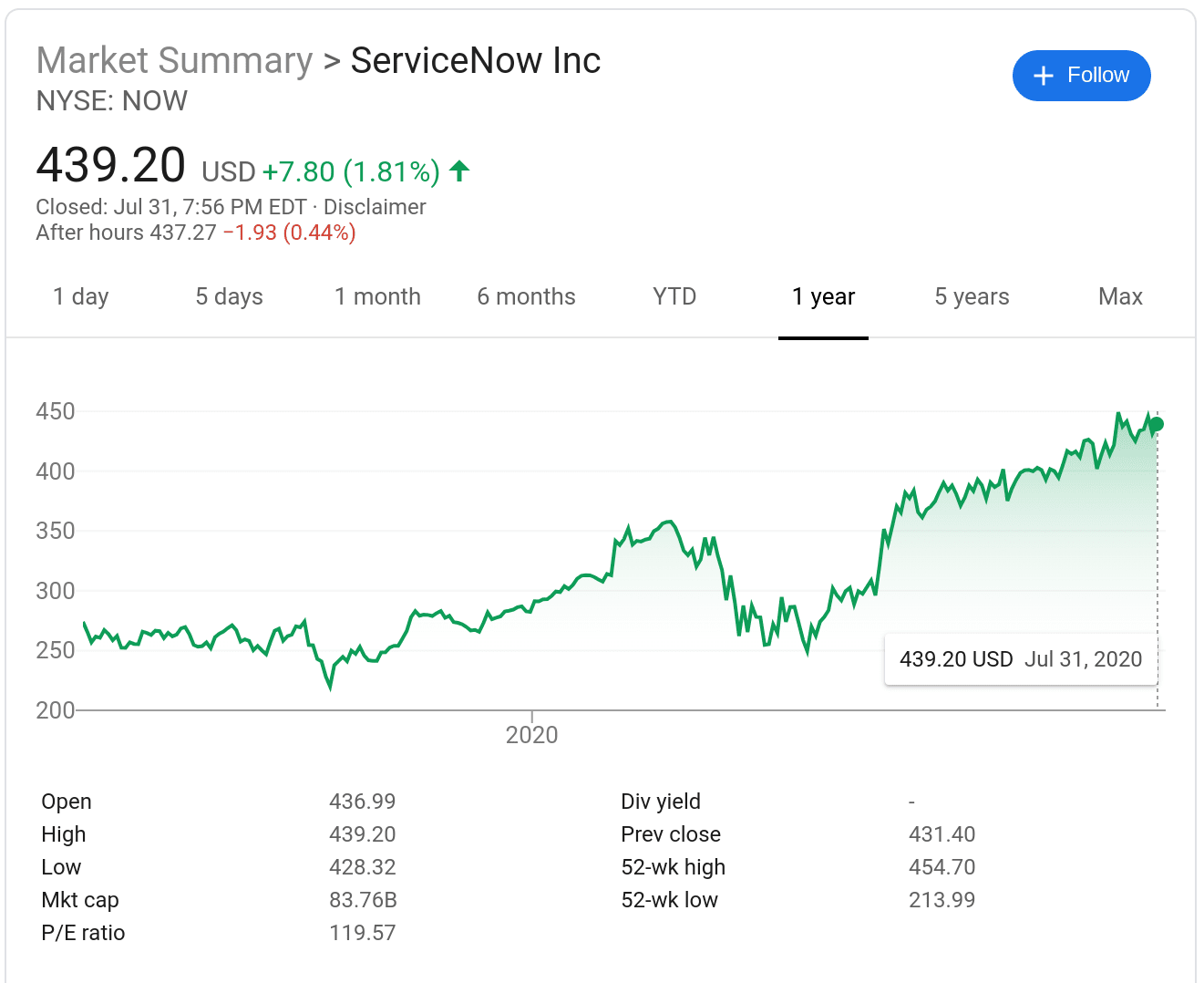
ServiceNow offers extremely overrated software.
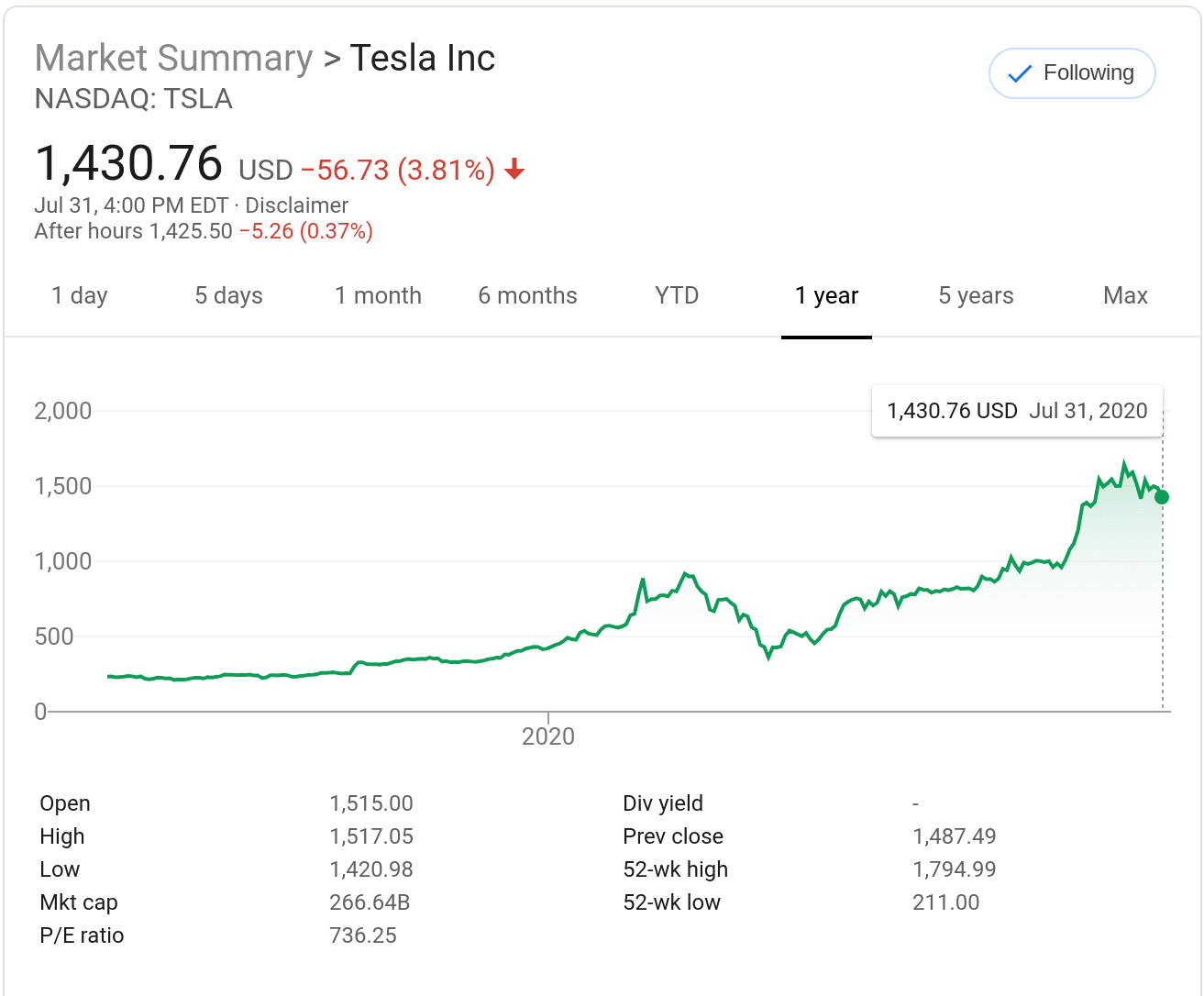 Tesla is selling at a P/E Ratio of 736.
Tesla is selling at a P/E Ratio of 736.
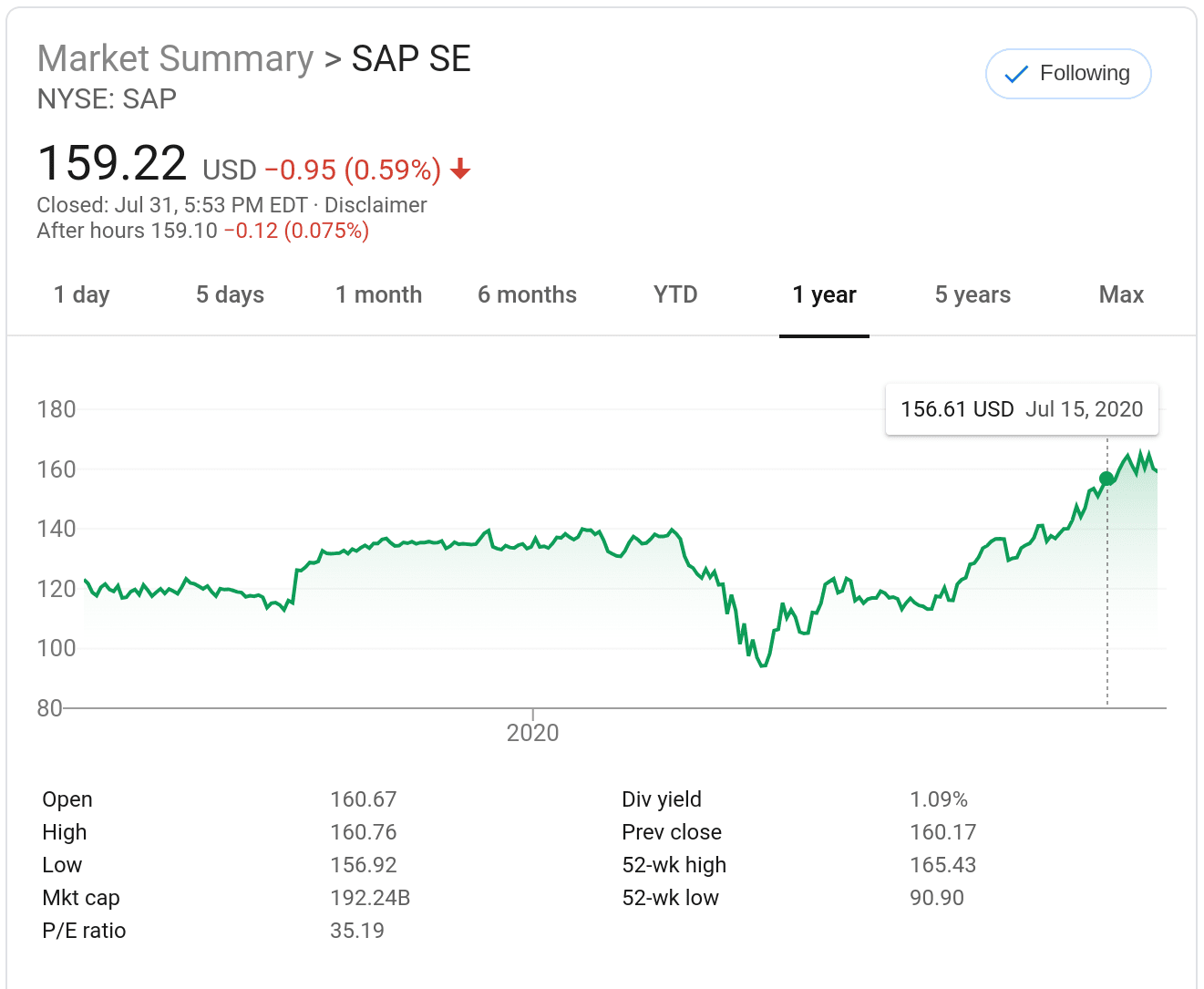
SAP is not a growth software company. SAP was consistently selling in the 120 range, which was already high. Notice in just the past quarter the increase.

Salesforce offers software that is widely used, but is poor in quality. It is a mature company. It fell with the Coronavirus but is now back up to where it was prior to the Coronavirus.
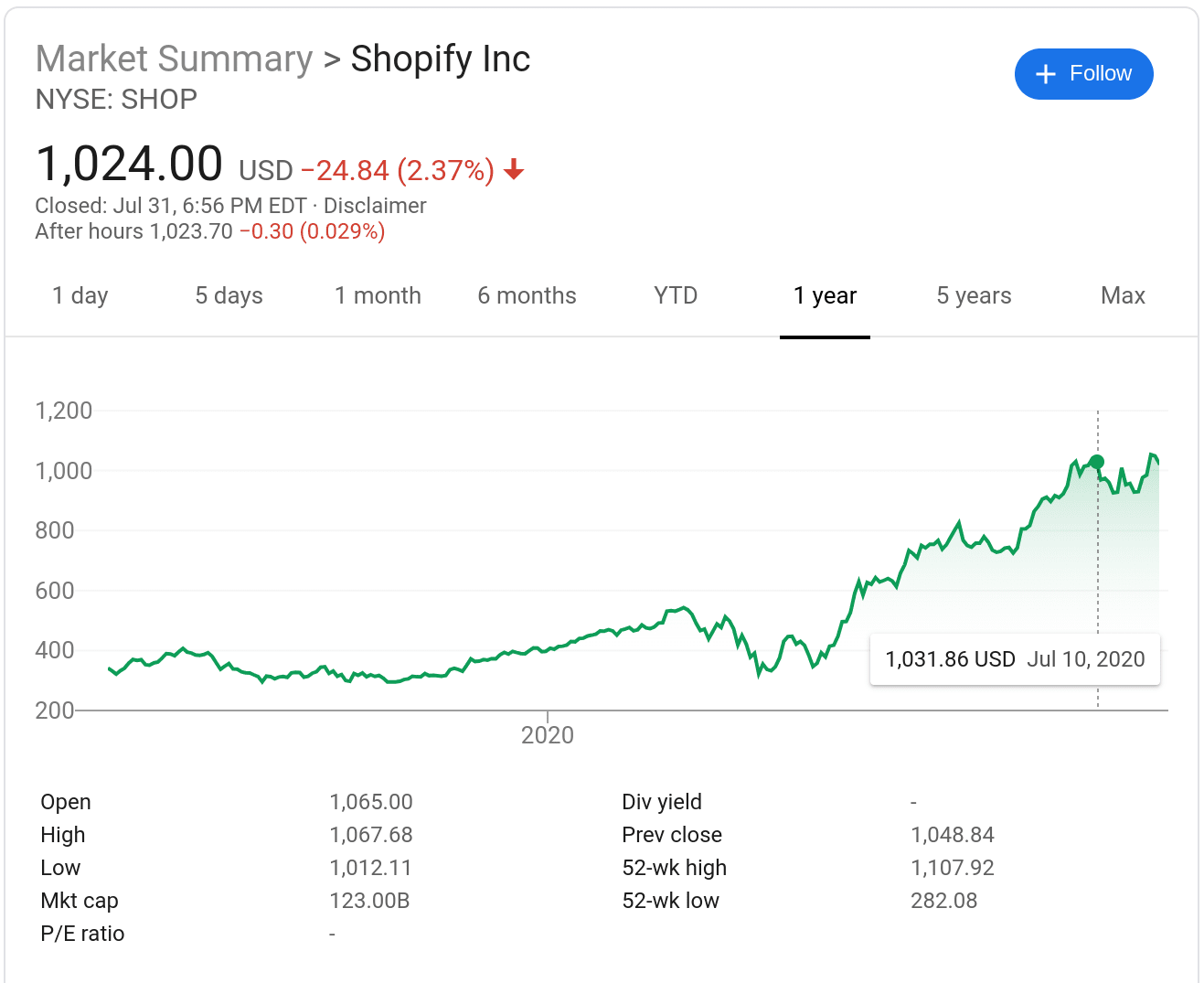
Shopify is at all-time highs. It shows the exact same pattern of a recent run up due to the Fed stimulus.

Shopify allows companies to have a web storefront, billing, shopping cart, etc.. But why the runup?
Amateur Night
“It is definitely a sign of a bubble,” said Matt Maley, chief market strategist for Miller Tabak. “That’s another sign of froth — people deciding, ‘I just need to bet, therefore I’ll bet on anything.’ And even though they don’t know anything about the stock market, they’re betting on it now. You’ve also seen that pick up in the options market, which is obviously a lot more speculative than the regular market.” – Bloomberg
Reddit Influencers
“We have Instagram influencers and now we have Reddit influencers,” QVR’s Eifert said. “They post a trade idea in an option, in a single name, and within an hour you see hundreds of thousands of call options placed, which is totally insane.” – Bloomberg
Technical Factors
The buying stampede has whipped up price momentum to levels not seen in almost three decades. At Monday’s close, 224 members in the S&P 500 had their 14-day relative strength index, or RSI, exceeding 70, a threshold considered by chartists as a sign of stocks running too far too fast. That’s the most since 1991. – Bloomberg
Part of the Reason the Coronavirus is Not Reflected in the Stock Market
He then pointed out that people confused by the market’s recovery were overlooking something else: The sector of the economy being hit hardest by the crisis, the small-business community, was not represented in major stock indexes like the Dow and the S&P 500. The market tracked the fortunes of big companies, not mom-and-pop shops. – New York Times
The Move Away from the Stock Market for Raising Money
A primary function of the stock market is supposed to be the allocation of capital to help companies grow. Yet fewer and fewer companies seem to want the market’s help. In 1997, there were roughly 7,500 publicly traded companies in the United States. That number has since fallen by half, to around 3,600 — a startling trend when you consider that the economy has more than doubled in size over the same period. How is it that the stock market lost so many listed companies at a time when the economy was growing so much larger, and where have they all gone? Some are no longer in business, while more than a few have been swallowed up through mergers or acquisitions. Lately, though, the decline has been driven by the growing allure and financial muscle of private equity and venture capital. Private equity is now a $5 trillion market, having increased threefold over the last two decades, according to a Milken Institute study, and there are now nearly 8,000 private-equity-owned companies in the United States, quintuple the number at the start of the 2000s. The appeal of private capital is obvious: Firms can obtain the funding they need without having to meet what they see as the onerous regulatory requirements of the public equity markets or having to answer to pesky Wall Street analysts. – New York Times
What is The Real Purpose of the Stock Market?
So, if companies are increasingly meeting their financing needs elsewhere, it seems fair to ask what exactly the point of the stock market is these days. The growth of high-frequency trading, in which players dart in and out of the market seeking to profit from the tiniest price discrepancies, certainly lends credence to the idea that the market is now little more than a glorified casino. Some observers, though, contend that it actually serves a more nefarious purpose — that the market, instead of directing capital to its most productive uses, has essentially become a mechanism for draining capital out of the economy in order to funnel ever more of the nation’s wealth upward. This is being done, goes the argument, primarily through stock buybacks — companies repurchasing their own shares. – New York Times
When Stock Buy Backs Were Re-Legalized
Henwood highlighted the role of stock buybacks, through which companies reduce the number of available shares on the market in order to raise the price. This practice was effectively banned after the 1929 crash because regulators saw it as a form of stock manipulation. But that restriction was lifted in 1982 as part of the financial deregulation that started under the Reagan administration. During the 1980s and ’90s, as ‘‘shareholder value’’ — the idea that a company’s primary obligation is to generate returns for its owners — became a mantra of American business and executive compensation was increasingly linked to a firm’s stock price, buybacks surged. Henwood noted that between 1984 and 1997, U.S. corporations repurchased $864 billion worth of their own shares. – New York Times
How Stock Buy Backs Drive the Stock Market
Now consider this: Yardeni Research reports that in 2019 alone, U.S. companies in the S&P 500 bought back $728.7 billion of their own stocks, which is equivalent to 3 percent of the country’s G.D.P. Not only that: According to Goldman Sachs, buybacks constituted the single-largest source of demand in the stock market, which was also the case in two of the previous three years. This was a period in which the stock market gained around 65 percent. To the extent that buybacks helped fuel the run-up, it suggests that the market was really just a hall of mirrors. – New York Times
The Real Purpose of Stock Buy Backs
This insightful comment was included in the New York Times article.
Regarding buybacks, it’s not about a misunderstanding by the public and returning profits to shareholders as indicated by Buffett and Siegel. The fact is that these companies were taking on big debt to enable them to buyback their shares – well in excess of their profits. Lets be very clear – they were buying their shares at all-time highs in an effort to artificially support those ridiculously high prices and attempt to push them even higher. That benefits management compensation. The evidence is all over the place. If it were true about how/why companies buyback shares, why have nearly all share buybacks come to a screeching halt recently? Shouldn’t companies be buying more of the shares when they are 30%, 50% or more lower than where they were throwing big money at the market buying the shares. Might the “experts” be making the argument that the companies were spending future profits repurchasing shares? For many of them, there will be no future for the path they have taken their companies down. Let’s look at Macy*s for example. They spent over a billion dollars buying shares at their all-time highs, all the way up into the $50 to $70 range. As the shares fell below $20 and all the way down below $5, no more shares have been purchased. The company is now on life support – which was in motion well before the virus. I sure bet that they wish they had all that money wasted on buybacks in their bank account instead of “having returned it to shareholders”. Call a spade a spade. – New York Times
Don’t Fight the Fed?
A full-blown U.S. stock market crash may not happen anytime soon or not for a few months as investors and traders are comfortable that the Federal Reserve supports the stock rally. Remember, the famous saying ‘Do not fight the Fed?’ Investors and traders have engraved this expression into their trading plan. The stock bubble could continue for a while longer. The Federal Reserve’s action can’t keep the coronavirus stock market rally going on its own for much longer. It needs help. In other words, it needs another stimulus injection—in trillions of dollars. So far, the mixture of fiscal and monetary policy support has worked well. – Forbes
Where Would the Market Be Without $7 Trillion in Stimulus?
This is another insightful comment that was included in the New York Times article.
Where would the market be if Fed didn’t step in with $7 T including trillions spent on supporting junk bonds? Fed has convinced investors that there is nor risk and investors responded accordingly. Yes, we may go higher, but the market as we know it doesn’t exist anymore. It’s artificial liquidity. How it ends is anybody’s guess.
How The Fed Works
This is another insightful comment that was included in the New York Times article.
For all the talk about “Free Markets”, the last 40 years have been a case of controlled markets – not control by the government directly (aka Communism/Socialism, etc) but by the Federal Reserve. The Fed pumps money into the system to make up for failures of the powerful participants in the markets – the banks, hedge funds, private equity investors, etc… and actively does not intervene to help the ordinary citizen or worker. They do this by their various purchasing programs and bailouts. What’s more, they encourage the Congress and the Executive not to intervene to help the ordinary citizen or worker either, rather to penalize them.
And this one..
While Main Street burns, the Federal Reserve props up Wall Street and Americans of wealth, thereby exacerbating the conditions of inequality which in part are at the root of the riots. If Donald Trump is reelected, he can thank Fed Chair Jerome Powell.
And this one..
The stocks market will never go down because it has unlimited insurance from the US govt and its institutions. When the choice comes to saving wall street or saving main street, the US govt and its institutions will always prefer wall street and direct maximum amount of money there while giving crumbs to main street. This is the story of the 2008 recession bailout and also of the current stimulus. Beyond bailouts, the greatest insurance provided by the US govt is unlimited free capital by keeping interest rates close to zero. Then there is direct intervention in the bond market to “stabilize” it. The US Fed has made it plenty clear that they will cross every self imposed red line to save the markets. The game is rigged for wall street and the investors know that, hence stocks will defy the overall pain in main street. People need to realize that the federal govt is for the giant corporation, by the giant corporation and of the giant corporation.
This quote describes the actual relationship between the financial system and the US Government.
The financial markets are a highly modulated, planned, and protected system of relations between our quasi-public institutions and wealthy companies and individuals. The life support now being undertaken via repo injections is more of the same. The major difference is that it’s coming at a time when all signs point toward the inevitability of recession.
Bizarrely, there is a possible silver lining in this gathering crisis. It is this: the old monetarist tricks are structurally played out. The Fed Funds rate is effectively at zero and the central bank has already taken over and semi-nationalized whole sections of finance. In the face of a new slump the cheap money strategy won’t work. The only polices that will revive growth will be the sorts that socialists are already demanding on purely ethical grounds: debt cancellation, free higher education, single payer health care, government jobs programs, and a Green New Deal to drive an energy transition. – Jacobin
The Predictions of Previous Bears Have Not Come True
Ironically, in stock market as prices rise higher and higher without the fundamentals to support that increase, the longer the warnings have been sounded and ignored, the more relevant they become. Only they do not appear so. These naysayers become largely discredited and ignored. Usually just as what they have been warning about is on the cusp of wiping out a large chunk of investors’ portfolios… – Forbes
Those with expertise in the stock market have been warning of a decline in the stock market for some time. Yet none of those predictions can come true.
It Has Become More Mainstream to Live Off of Hopes and Dreams
CEOs who can’t point to years of substantial Cash Flow or sustainably high Returns on Invested Capital (ROIC), usually prefer not to talk about current results too much. Instead, they would rather you focus on tomorrow. Or more perhaps on 5 or 10 years out.
They are eager to tell you about the castles they will build and the industries they will conquer. Maybe they will, or maybe they won’t. The fact that they are successfully shifting investors’ attention to hopes and dreams that are far removed from the current results speaks volumes about the current stock market environment. – Forbes
But When?
Richard Wolff predicted a stock market crash 6 months ago. But the stock market has increased since this prediction. Of course, he did not make a specific date prediction, that it could happen in either 2020 or 2021. One of the issues brought up by Wolff is that debt levels are very high. He describes the situation of a crash combined with very high debt.
A Likely Trigger
The asset bubble in the stock market is in part depending upon the illusion that the US will come back to normal.
The US Government is doing very little to support the overall population, which is where demand comes from.
However, up until now, the real housing defaults and rental nonpayment have not yet hit.
Ray Dalio
One of the more systematic analyses we found on this coming bubble popping is from Ray Dalio.
Ray is analyzing this topic from the perspective of historical crashes. Ray sees a transition from the US being the preeminent world power to the Chinese being that power. The last thing to go with a country’s prominence is the loss of its status of being the world’s reserve currency.

Anyone who lives in the US can see this cycle, and see that the US is in the Printing Money and Credit phase.
The problem is of course, that the US did the same thing in 2008 in response to the sub-prime mortgage crisis. Therefore, the question is whether this is just a bubble pop to the stock market, or the great slide down of the US, which accompanies the stock market bubble bursting.
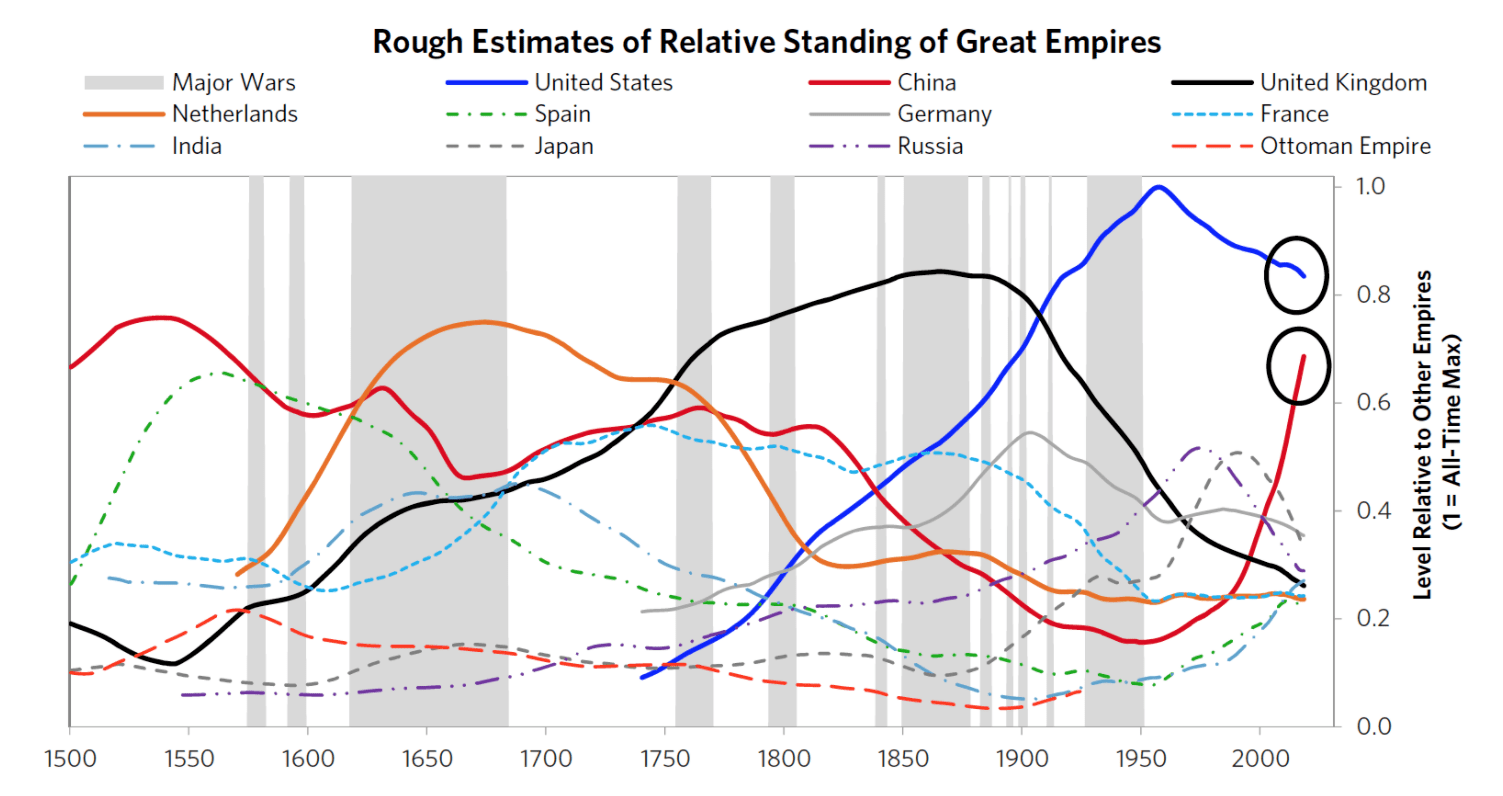
This shows the decline of the US versus China. It appears that very soon China is to overtake the US. It may be in the next few years or beyond this. It should be noted that the US is considerably weakening. Its elite financial numbers look good — but the economy has become mostly about benefiting the elite in the country.
Dalio also says that economic wars start around 10 years before shooting wars. The US and China are clearly in an economic war, even though, the US entirely enabled the rise of China.
Because the United States and China are now in an economic war that could conceivably evolve into a shooting war, and I’ve never experienced an economic war, I studied a number of past ones to learn what they are like. That taught me a bit about economic warfare, helped me better understand what is happening now, and made me aware of possibilities that I hadn’t previously considered. Comparisons between the 1930s leading to World War II and today, especially with regard to economic sanctions, are especially interesting and helpful in considering what might be ahead. For that reason, I delve into the story of this period in a bit more detail than you might care to read. If you find that to be the case, just read the bold for the highlights. – Ray Dalio
The Coronavirus and Lessons from the Past
To make matters worse droughts in the US and in the Soviet Union soon followed. The drought/famine in the Soviet Union, in combination with extreme government policies, was so severe that it caused millions of deaths. Harmful acts of nature (e.g., droughts, floods, and plagues) have often caused periods of great economic hardship that when combined with other adverse conditions have led to periods of great conflict. Over the next several years in Russia internal political fighting and fears of Nazi Germany led to purges of hundreds of thousands of people who were accused of spying and shot without trials. – Ray Dalio
Lessons for What Happened to Japan Before the War
Like Germany, Japan was also hit exceptionally hard by the depression and became more autocratic in response to it. Japan was especially vulnerable to the depression because, as an island nation without adequate natural resources, it relied on exports for income to import necessities. When its exports fell by around 50% between 1929 and 1931, it was economically devastated. In 1931, the depression in Japan was so severe that the country went broke—i.e., it was forced to draw down its gold reserves, abandon the gold standard, and float its currency, which depreciated it so greatly that Japan ran out of buying power. These terrible conditions and large wealth gaps led to fighting between the left and the right. In 1932 that led to a massive upsurge in right-wing nationalism and militarism to forcefully restore order and bring back economic stability. To that end, Japan’s military took control and pursued military options to get Japan the resources it needed by taking them away from other countries.
In 1934, there was severe famine in parts of Japan, causing even more political turbulence and reinforcing the right-wing, militaristic, nationalistic, and expansionistic movement.
Ray Dalio has some interesting observations. As a synopsis, he sees a steep decline for the US stock market and a potential loss of some of the US dollar’s standing as a reserve currency, along with a depreciating dollar. In fact, there are many voices promoting the decline of the US dollar.
Conclusion
The stock market is riding Fed stimulus. The stock market as this article is published, on the first of August 2020, the market is higher today than it was before the Coronavirus hit the US. We now have no way out of Coronavirus. Every time states open, they get hit with more Coronavirus cases.
The US government has also shown tremendous incompetence in managing Coronavirus leading to a very confusing message coming from the US Government. This further means that it is unlikely the US government will figure out a logical response to Coronavirus and that the US will continue with a confused response to the pandemic. In this way, the Coronavirus situation looks worse than even when it first broke, because at that point there was at least the hope that there would be a fast recovery.
This video brings up the question of what happens when mass defaults hit the housing and rental market. Wolff predictions a crash worse than the Great Depression.
The Decline of the US Currency
It appears quite likely that the US currency will also take a hit.
The predicted loss of the US dollar as a reserve currency brings up the question of what would replace it. It is not the Euro and the Chinese Yuan is not a freely floating currency.
Despite the tumble, few on Wall Street believe the dollar is on the brink of losing its status as the world’s reserve currency, held in bulk by global central banks and used to finance most international transactions. The dollar remains relatively strong following its long climb, and analysts say economic data points like export growth justify the reversal. – Wall Street Journal
It is not known how long the Fed can continue to stimulate the Stock Market and have investors respond positively. But this stimulus will certainly eventually have negative long term ramifications.
This video describes overpriced stocks.
The Trigger
The stock market has not responded to terrible economic or employment news. In our view, the most likely trigger for the decline is the coming rise in mass foreclosures and rental delinquencies leading to mass evictions. As of August 1st, that is coming up around the corner.
References
https://www.bloomberg.com/news/articles/2020-06-13/robinhood-market-made-bursting-bubbles-wall-street-s-obsession
https://www.linkedin.com/pulse/changing-world-order-ray-dalio-1f/
https://www.wsj.com/articles/behind-the-vast-market-rally-a-tumbling-dollar-11596360601
https://www.linkedin.com/pulse/chapter-4-big-cycle-united-states-dollar-part-1-ray-dalio/
https://en.wikipedia.org/wiki/2020_stock_market_crash
https://www.nytimes.com/interactive/2020/05/26/magazine/stock-market-coronavirus-pandemic.html
https://www.forbes.com/sites/naeemaslam/2020/07/31/stock-market-crash-is-the-end-game-here/#3fbf85d121cc
*https://wallstreetonparade.com/2020/06/wall-street-veterans-call-out-the-fed-for-creating-a-dangerous-stock-market-bubble/
*https://www.forbes.com/sites/jeffcamarda/2020/07/13/does-sp-500–us-economy–covid-stock-bubble/#79743d9d5daa
https://www.jacobinmag.com/2020/03/stock-market-recession-socialized-finance
With the Federal Reserve’s main interest rates at close to zero, another conclusion is also clear: policy makers are trapped. If the current downturn snowballs into a full-blown financial panic and then into a wider economic crisis, only egalitarian economic redistribution aimed at working people and the real economy will drag capitalism from the slump. The old tricks of deregulation, regressive tax cuts, and shots of public credit have worn out. The real economy needs help in the form of popular debt forgiveness, green public works, free higher education, and significant socialization of health care.
Most important was his highly regressive $1.5 trillion tax cut of 2017. Like every trickle-down economics ruse before it, the claim behind this tax cut was that it would stimulate the real economy. Money that would have been paid as taxes would now, the theory went, be invested in hiring new workers, buying new machinery, innovating new product lines, etc. In reality, this money was mainlined directly into financial markets.
The effective corporate tax rate was cut in half from 17.2 percent in 2017 to 8.8 percent in 2018. Tax rates on repatriated foreign profits were also slashed from 35 percent to 15.5 percent. And the $664 billion that firms repatriated from overseas tax havens did not go into higher wages or new investment in productive activities. Instead, the vast majority of that money helped fund 2018’s staggering $1.1 trillion in stock buybacks — the largest in history — thus inflating stock prices even more!
Then came three interest rate cuts in 2019, pushing yet more money into the financial markets. Fed Chair Jerome Powell had been trying to raise rates, but constant harassment from Trump, accompanied by a still precarious financial system, seem to have encouraged him to reverse course.
At the level of individual firms, this tsunami of money encouraged new rounds of dangerous borrowing. Since the financial crisis corporate debt has swelled to record levels — over $10 trillion, equal to 48 percent of GDP. Companies haven’t been this heavily leveraged since 2009, at the depth of the crisis. In January the New York Fed reported that only two US companies — Johnson & Johnson and Microsoft — still carry triple-A ratings.
https://www.jacobinmag.com/2020/06/wall-street-coronavirus-pandemic-recession
Implications of the Cornavirus for international economies.
The International Labor Organization expects that during the second quarter of 2020, 6.7 percent of global working hours will be cut, leading to an additional 195 million global job losses. The hardest hit will be those in the informal sectors of the developing world in places like Brazil and Nigeria. In India, nearly 400 million informal workers are at risk of sinking into even deeper poverty.
https://www.ccn.com/beware-stock-market-bubble-the-fed-wont-save-investors-forever/
https://www.jacobinmag.com/2013/11/wall-street-isnt-worth-it
The financial services sector as a whole accounts for more than 20% of US GDP, and this share has grown by around ten percentage points since the 1970s. Additional expansion has taken place in the business services sector, encompassing law and accounting firms and other outgrowths of a financialized economy. Overall, it seems reasonable to conclude that Wall Street in its various forms accounts for around 20% of total US income, a share comparable to that of the US government.
The rapid growth in incomes accruing to the financial sector has been accompanied by slow growth or stagnation in incomes for the rest of society. Moreover, aggregate income growth over the entire period of market liberalism, including the current recession, has been weak. The rise of Wall Street has left the rest of society with a diminished share of a smaller (more precisely, slower-growing) pie.
https://seekingalpha.com/article/4360897-tesla-bubble-might-finally-pop